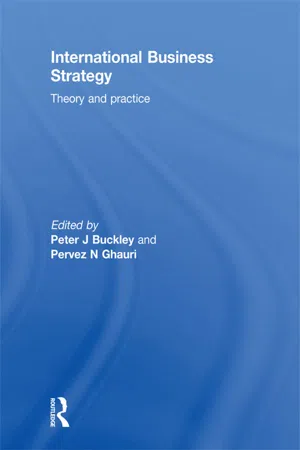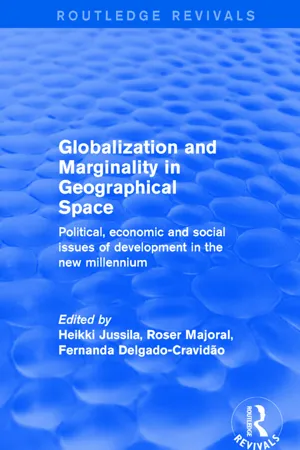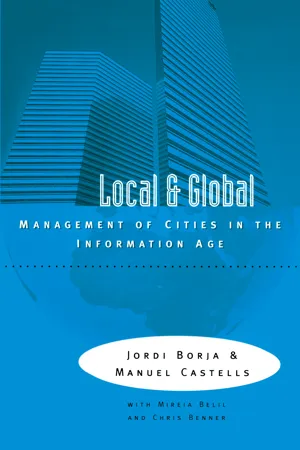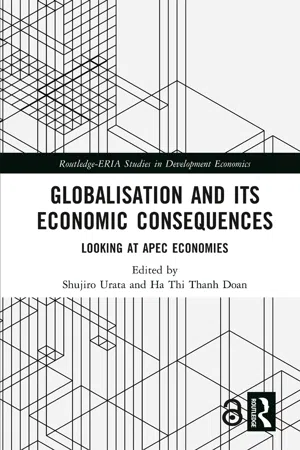Geography
Effects of Globalisation
Globalization has led to increased interconnectedness and interdependence among countries, resulting in the flow of goods, services, information, and people across borders. This has brought about both positive and negative effects, including economic growth, cultural exchange, and environmental challenges. The impacts of globalization vary across different regions and communities.
Written by Perlego with AI-assistance
Related key terms
6 Key excerpts on "Effects of Globalisation"
- eBook - ePub
Immigrants, migratory system
controversial aspects from a legal and humanist scope
- Alex Alves do Nascimento(Author)
- 2021(Publication Date)
- Editora Dialética(Publisher)
Our first focus of the impact of immigration on globalization is the aspect of economics.This interconnectedness amongst humans on the planet is sometimes also referred to as the ‘global village’ where the barriers of national and international boundaries become less relevant and the world, figuratively, smaller place. The process is driven economically by international financial flows and trade, techno- logically by information technology and mass media entertainment, and very significantly, also by very human means such as cultural exchanges, migration and international tourism. As one commentator remarked, we now live in a net- worked world. While globalization is not a new process, it has accelerated rapidly since World War II, and is having many effects on people, the environment, cultures, national governments, economic development and human well-being in countries around the world.”The globalized world seems to be dwindling. Independent nations that conquered with difficulty their sovereignty, gather today in international communities, giving up part of their independence for the sake of better development. This brings to mind a feudal world, where the lord of every corner of the kingdom was the owner and possessor of the land, but garnished his loyalty to the king, who al- lowed their survival and ensured their safety and autonomy in relation to other realms.Over all powers in the Middle Ages, the Church hung. In actuality, it hovered over all nations, exerted a powerful influence on national political decisions, similar to the power the Church wielded in medieval societies, is transnational capital: remains apart and above the kingdoms / independent countries.In this modern village, people are persistently affected by new developments that were seen as science fiction a few years ago. The means of transport has become increasingly speedier and more efficient. One perfect example is the 50 km tunnel that connects England to the European continent. In its short distance, it was constructed both underground and underwater.Communication, already considered modern with the advent of the telegraph, is now transmit- ted instantaneously, using satellites. In this scenario, it appears that no distance is too far. This is especially true for today’s immigrants, who may always have a way home and a way to communicate with those they left behind. - eBook - ePub
International Business Strategy
Theory and Practice
- Peter J Buckley, Pervez Ghauri, Peter J Buckley, Pervez Ghauri(Authors)
- 2015(Publication Date)
- Routledge(Publisher)
The NIDL, global commodity chains and (regional) production networks all fit well with the international business research agenda. The progress of research in this area depends on inter-disciplinarity and connectivity.Economic geography has a long history (Clark et al., 2000; Krugman, 1991 , 2000 ) and is currently enjoying a renaissance (Scott, 2000 ). The importance of the new geography is attested to by the concern for ‘the new geography of competition’ for mobile investment (Raines, 2003 ) and the increasingly complex interplay between states, economic regional blocs such as the EU and subnational regions such as states in the USA and semi-autonomous regions such as Catalonia or Scotland (Oxelheim and Ghauri, 2003 ; Phelps and Alden, 1999 ; Phelps and Rains, 2003 ).Economic geographers have made many significant contributions to the analysis of globalisation that can, with profit, be noted by international business scholars. Regional integration and the division of world markets into trade and investment blocs have been extensively analysed by geographers (for summaries on Asia, North America and Europe, see Abo, 2000 ; Holmes, 2000 ; and Amin, 2000 ). However, the incorporation of real geographical features such as climate, coastline, river transport, soil quality and terrain has perhaps been underplayed and this represents a real opportunity for future development. This links physical geography and economic development. A research agenda of this kind is proposed byMellinger et al. (2000)and Buckley and Casson (1991) - eBook - ePub
Globalization and Marginality in Geographical Space
Political, Economic and Social Issues of Development at the Dawn of New Millennium
- Heikki Jussila, Roser Majoral, Fernanda Delgado-Cravidao(Authors)
- 2017(Publication Date)
- Routledge(Publisher)
credo of profit-maximization/cost-reduction.This economic definition of globalization is only part of the story. The German sociologist Ulrich Beck (1997) looks at it from a much wider perspective. In fact, every individual on the globe, without exception, is in some way or another a global actor or player. This is so obvious that we tend to overlook it. As consumers of goods and information, we are linked to the whole world every day, and as scientists we would be at a loss without our global networks.Globalization in its economic definition is therefore an inadequate term for the description of the global phenomenon. As a consequence, Beck (1997) widens the field of notions. Thus, globalism is ‘the idea that the world market ousts or replaces political actions, i.e. it is the ideology of the domination of the world market or of neoliberalism’ (p. 26) whereas globality is ‘the global society in the sense that the idea of closed spaces becomes fictitious. No country, no group can shut itself off from others’ (p. 27). Globalization, then, is defined as ‘the processes, as a consequence of which nation states and their sovereignty are suffused and linked by transnational actors, their chances of power, their orientations and their networks’ (p. 28; emphasis in the original). Applied to humans, this means that we all take part in globality (we live in the global village) and are victims to the process of globalization which leads to globalism.Many people suggest that the world’s problems can be solved by acting globally, and in a way this may be true. However, this discourse is coloured by a variety of ideological backgrounds (Bertrand, 1994, p. 1), ideologies which lead to numerous and often contradictory moral and political prescriptions (liberal, developmental, ecological, federalist or Marxist political views). In addition, by privileging the global scale, the importance of all other scales is ignored and the arguments become extremely simplistic. There are many local and regional problems, which have little impact on the global system, and a global problem may not be felt at the local level. This holds good even if we agree that there is a global unity, that everything is tied to everything, that the transformation of one tiny element in the system influences all other elements. After all, as geographers we have always been thinking in different scales, and we are used to comparing them – global problems are not new to us: - eBook - ePub
Local and Global
The Management of Cities in the Information Age
- Jordi Borja, Manuel Castells(Authors)
- 2013(Publication Date)
- Routledge(Publisher)
Chapter 2 The Impact of Globalization on the Spatial and Social Structure of Cities I NTRODUCTION The process of globalization, and the informationalization of the processes of production, distribution and management, are profoundly altering the spatial and social structure of societies all over the planet. This is the most direct meaning of the articulation between the global and the local. The socio-spatial effects of this articulation vary according to the levels of development of the countries, their urban history, their culture and their institutions. Yet it is in this articulation that the sources of new urban transformation processes lie — and hence the points of intervention for urban, local and global policies capable of reversing the process by which the quality of life in cities deteriorates. Our analysis is organized around a sequence of three issues that synthesize and seek to make sense of a mass of apparently disparate information: the articulation of the local and the global in the new, strategically dominant productive processes — advanced services and high-tech industry; the emergence of new patterns of spatial settlement, both in developed and in developing countries, special attention being given to the emergence of megacities, ‘dispersed city’ models, and the articulation between old and new forms of urbanization; and establishing an urban quality on the basis of intrametropolitan space-polarization processes, in a historically new sense, as we shall attempt to show in our analysis. L OCAL M ANAGEMENT OF THE G LOBAL E CONOMY : G LOBAL C ITIES OR G LOBAL N ETWORKS OF U RBAN N ODES ? The global informational economy is organized on the basis of managerial centres capable of coordinating, managing and innovating the activities of companies structured in networks for interurban, and often transnational, exchange (Hall, 1995) - eBook - ePub
- Cynthia Metcalf, Rhonda Atkinson, Rhonda Atkinson(Authors)
- 2017(Publication Date)
- Research & Education Association(Publisher)
distance decay , in which the interaction between two places declines as the distance between the two places increases. Imagine putting a magnet on your desk and putting an iron nail on it. The farther you pull the iron nail away from the magnet, the less of a pull effect the magnet has on the nail. It is the same with distance decay; as the distance between two entities increases, the effect of their interaction decreases. However, improved transportation and communication technologies have reduced the effect of distance decay on most human interactions. On any given day in 1850, a person living in Atlanta probably never interacted with someone from 30 miles outside the city. Now a person in Atlanta can interact with people from all over the world via the Internet and improved transportation.Element 5: Environment and SocietyHumans modify the Earth’s environment through their actions. Such actions happen largely as a consequence of the way people value or devalue the Earth’s resources. This element consists of the following standards:1. how human actions modify the physical environment;2. how physical systems affect human systems;3. the changes that occur in the meaning, use, distribution, and importance of resources.Geographers look at both the positive and negative effects that result from human interaction with the environment: how humans rely on the environment, alter it, and adapt to it—and how the environment may limit what people are able to do. Much of the way that people relate to the environment reflects their economic and political circumstances, as well as their culture and their technological capabilities. One significant issue is that the interaction between humans and the environment can change quickly, and such change might be temporary. For instance, building a dam changes the environment, but then floods, earthquakes, drought, or mudslides could destroy the dam and change the environment again.Element 6: The Uses of GeographyGeography informs people about the relationships they have between place and environment over time. This element explores how humans modify the physical environment, how physical systems affect human systems, and how the changes occur in the meaning, use, distribution, and importance of resources both in the past and potentially in the future. This element addresses the following standards: - eBook - ePub
Globalisation and its Economic Consequences
Looking at APEC Economies
- Shujiro Urata, Ha Thi Thanh Doan, Shujiro Urata, Ha Thi Thanh Doan(Authors)
- 2021(Publication Date)
- Routledge(Publisher)
8 The economic consequences of globalisation in the United States Peter A. Petri and Meenal BangaDOI: 10.4324/9781003138501-81 The globalisation debate
In 1999, Merrill Lynch, a leading wealth manager in the US, took out full-page ads in major US newspapers to celebrate the era of globalisation: ‘The World Is 10 Years Old. It was born when the Wall fell in 1989.’ The ads argued that the ‘spread of free markets and democracy around the world is permitting more people everywhere to turn their aspirations into achievements. And technology, properly harnessed and liberally distributed, has the power to erase not just geographical borders but also human ones.’The current era of globalisation began in the 1970s, when the share of trade in world output was around 10% (Figure 8.1 ). Globalisation accelerated in the 1980s, when the share of world trade in output surpassed historical records, eventually climbing to about 25% by 2009. Since then, the trade share of GDP has flattened. For reasons ranging from trade policy to technological changes and the maturation of international supply chains, trade intensity is not likely to rise as fast in the future as it did in recent decades.Figure 8.1 Value of Exported Goods as a Share of Gross Domestic Product.Source: Fouquin and Hugot (2016) .Note: GDP = gross domestic product.The unprecedented rise in global interdependence has been very productive. World GDP growth, which hovered in the 2% per year range in the 1970s and early 1980s, doubled to reach the 4% range before the global financial crisis. Growth spread to the world’s largest countries and lifted more than a billion people out of extreme poverty. New global supply chains brought emerging, trade-oriented economies into the network of global expansion. However, the fragility of rapid, interdependent growth also became apparent. In 2008, Merrill Lynch succumbed to the global financial crisis. Meanwhile, criticism of the distributional Effects of Globalisation, particularly in advanced countries, intensified as Piketty (2015)
Index pages curate the most relevant extracts from our library of academic textbooks. They’ve been created using an in-house natural language model (NLM), each adding context and meaning to key research topics.





